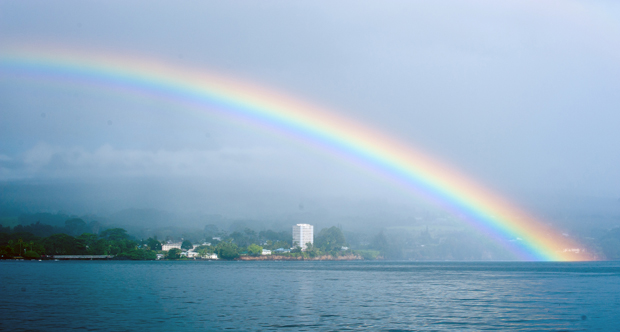
University of Hawaiʻi at Mānoa researchers determined that heavy rainfall events have become more frequent over the last 50 years on Hawaiʻi Island. For instance, a rare storm with daily precipitation of nearly 12 inches, occurring once every 20 years by 1960, has become a rather common storm event on the Big Island of Hawaiʻi— returning every 3 to 5 years by 2009.
In a paper titled “Trends in precipitation extremes and return levels in the Hawaiian Islands under a changing climate” published in the International Journal of Climatology, Ying Chen, a UH Mānoa graduate student at the time of the study, and Pao-Shin Chu, professor of atmospheric sciences at UH Mānoa and head of the Hawaiʻi State Climate Office, analyzed extreme precipitation events and the frequency with which they occur on three islands in Hawaiʻi–Oʻahu, Maui and Hawaiʻi Island.
While heavy rainfall events have become more frequent over the last 50 years on the easternmost island in Hawaiʻi, the opposite behavior is observed for Oʻahu and Maui to the west. There, rainfall extremes have become less frequent in the last five decades. This study, therefore, also reveals a regional—that is, east to west—difference in how precipitation patterns are responding to a changing climate.
“In the past, the frequency of heavy rainfall events was assumed to be fairly constant. However, because climate is changing, the assumption of stable precipitation climatology is questionable and needs to be reconsidered,” said Chu.
“Changes in the frequency of heavy rain events have repercussions on ecological systems, property, transportation, flood hazards and engineering design—including sewage systems, reservoirs and buildings.”
This study also provides clues about why and how the frequency of precipitation extremes has changed. Chu and Chen found a greater number of extreme rain events during La Nina years and the opposite during El Nino years.
In this study, the number of rain gauges used was limited—the researchers used information from 24 weather stations on the three islands. For future work, Chu hopes analyzing data from additional stations will provide a more detailed assessment of changing rain patterns across the Hawaiian Islands.
—By Marcie Grabowski

